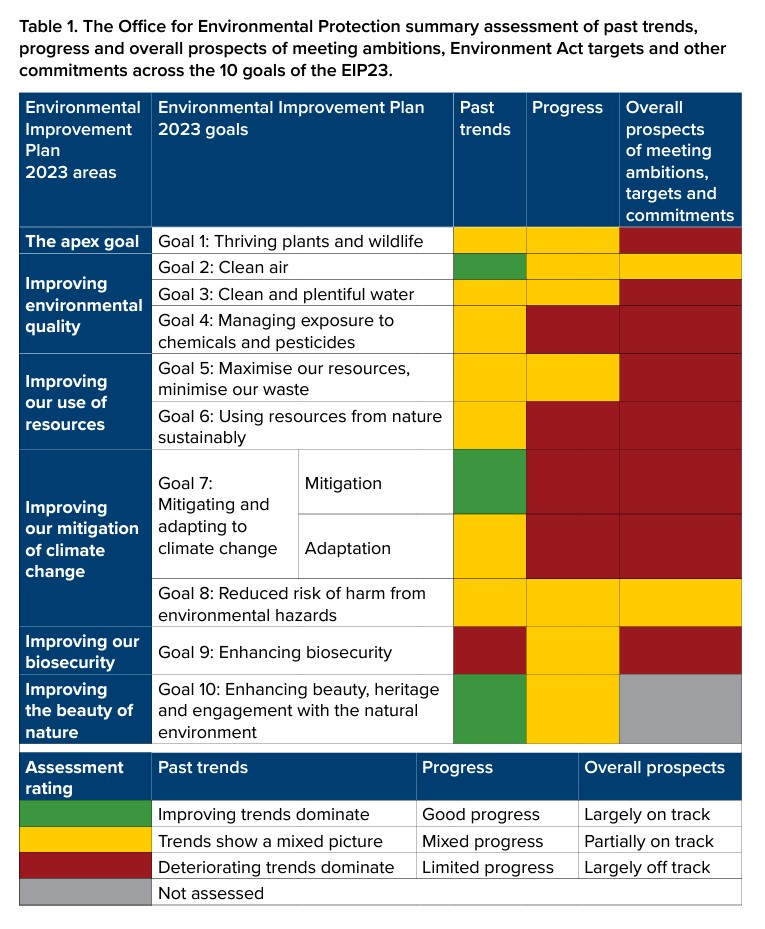OEP slams government for poor performance on environment and nature
 The Office for Environmental Protection (OEP) has today published its report on the government’s progress in improving the natural environment in England.
The Office for Environmental Protection (OEP) has today published its report on the government’s progress in improving the natural environment in England.
The report finds that the government “remains largely off track to meet its environmental ambitions“.
The OEP report provides an assessment of the government’s progress towards legally-binding environmental targets and the goals of its Environmental Improvement Plan (EIP). It covers the period 1 April 2022 to 31 March 2023. It also includes content on selected cross-cutting themes, such as nature-friendly farming, and a more in-depth assessment focused on government’s apex goal of achieving ‘thriving plants and wildlife’.
The OEP last reported on the government’s progress in meeting its stated ambitions for the environment in January 2023. They concluded that progress in improving the natural environment over the year under review had fallen far short of that required to realise government’s vision. The OEP urged the government to change gear immediately: to provide more, bigger, better and joined-up habitats, to protect and restore species, and, with an estimated 70% of land in agricultural use, to incentivise farmers to maintain good stewardship of the land they occupy. They made specific recommendations – on setting ambitious interim targets, developing governance and oversight, focusing on delivery planning and implementation, and improving monitoring, evaluation and learning. And the OEP hoped to see those recommendations followed through as government revised its Environmental Improvement Plan, early in 2023.
However, a year on from the last report, the OEP concludes that while some progress has been made, very substantial challenges remain. Government is largely off track to meet its stated ambitions, statutory targets and other commitments.
This latest OEP assessment of 40 individual environmental targets, including legally binding targets set under the Environment Act 2021, found government is largely on track to achieve 4, partially on track to achieve 11, and largely off track to achieve 10. It was not possible to assess progress against a further 15 targets due to a lack of sufficient evidence. Targets where government is largely on track relate to specific pollutants and wastewater. Targets where government is largely off track span most EIP goal areas and include residual waste, sustainable fisheries, chemicals and improving nature.
The OEP’s assessment of 51 recent environmental trends found that 25 trends are improving, 10 are static, 8 are deteriorating and 8 could not be assessed due to a lack of data. Most progress has been made on reducing some environmental pressures – such as emissions of some air pollutants, greenhouse gases and chemical pollutants.
 Looking at what this means for progress across the 10 goal areas of the EIP, the OEP concludes that in 7 of the 10 goal areas progress has been mixed, and in 3 progress has been limited.
Looking at what this means for progress across the 10 goal areas of the EIP, the OEP concludes that in 7 of the 10 goal areas progress has been mixed, and in 3 progress has been limited.
In terms of the overall prospects of government meeting its ambitions for significantly improving the natural environment, the OEP concludes that in 7 goal areas, including the apex goal of achieving ‘thriving plants and wildlife’, government is largely off track. In 2 goal areas, government is partially on track (‘clean air’ and ‘reducing the risk of harm from environmental hazards’), and in 1 area, ‘enhancing beauty, heritage and engagement with the natural environment’, progress could not be assessed due to a lack of evidence.
The report identifies factors impeding progress:
- Key policies, strategies and regulatory frameworks are announced and anticipated, but not then developed or delivered. For example, major initiatives, such as a Chemicals Strategy and a Land Use Framework, are long awaited. This creates uncertainty, presents barriers to progress, and results in missed opportunities.
- Actions are not addressing all major pressures. For example, for water quality, commitments to investment have increased substantially in some but not all areas of need.
- Resources are not always allocated as needed, even when tools and actions are well understood. For example, there is an approach in place for tackling invasive non-native species, but resources are inadequate to implement actions at the scale required to achieve desired outcomes.
- The urgency with which positive actions are being implemented is frequently lacking. For example, the current rate of tree planting needs to substantially increase to achieve woodland creation goals.
The report reaffirms the key recommendations that the OEP made following last year’s assessment of progress, and makes further detailed recommendations for each goal area of the EIP. The key recommendations are that government should:
- implement the Environmental Improvement Plan 2023 effectively;
- develop and implement clear and effective governance;
- develop and implement delivery plans;
- set and vigorously pursue clear and achievable interim targets; and
- develop and implement an effective monitoring, evaluation and learning framework.
